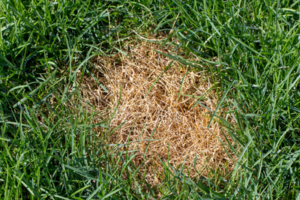Summer is a time when homeowners find themselves dealing with lawn care problems created by diseases. One way to keep lawns healthy is by implementing a smart disease management plan.
First things first: the most common reasons why grass turns brown or yellow is because of a lack of rainfall or irrigation, improper mowing techniques when grass is stressed, or other improper maintenance issues. What we’ll address here are infectious diseases caused by fungal pathogens.
Some of the more common turfgrass diseases in the summer heat are Summer Patch and Brown Patch, Fairy Ring, and Gray Leaf Spot.
[Read our Summer Series: Part 1 Lawn Care Extreme Heat | Part 2 Lawn Care and Drought]
Summer Patch appears as brown thinning crescent- or circular-shaped patches in your lawn, often when temperatures are regularly over 85 degrees. To deal with this disease, mow grass at a taller than normal height, remove thatch buildup, and renovate damaged areas with resistant grasses.
 Brown Patch is a disease that presents itself by yellow rings or patches in sunken grass. Humid conditions help this fungus to infect your lawn. Avoid excessive nitrogen fertilization to help combat this disease. Wait until fall to apply fertilizer if you can.
Brown Patch is a disease that presents itself by yellow rings or patches in sunken grass. Humid conditions help this fungus to infect your lawn. Avoid excessive nitrogen fertilization to help combat this disease. Wait until fall to apply fertilizer if you can.
Fairy Ring will appear as brown circles over long stretches of dry, hot weather. But it may first show up as dark green in color, with a white fungal mat in the thatch area of the circle. It may also have a musty smell. You may even see mushrooms growing inside the ring. A solution to this disease is deep watering and aeration to break up compacted soil.
Gray Leaf Spot is commonly found in shady and wet sections of a lawn. You’ll notice small, oblong dark flecks with a gray center; grass may quickly wither. Control this disease with good ventilation and keep it mowed.
Other widespread lawn diseases include dollar spot, gray snow mold, and powdery mildew.
Most lawn fungus issues can be prevented and resolved with proper maintenance such as frequent and thorough irrigation to let water seep deep into the soil and renovate damaged areas with resistant grasses.
Note: it is critical to correctly identify diseases before choosing a control/treatment strategy. If you’re unsure what you’re dealing with, consult an independent lawn care expert to help diagnose your problem.
Your local independent lawn and landscape dealer can give you advice on any specific problems or concerns that you have. They can also recommend reputable landscapers who can test the quality of your soil, provide the proper nutrients, and give you expert advice on how to keep your lawn looking great. To find a dealer near you, click here.

